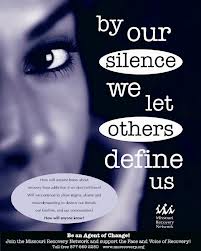 More insightful writing from Bill White and colleagues.
More insightful writing from Bill White and colleagues.
‘Debates continue on whether the stigma attached to persons experiencing alcohol and other drug (AOD)-related problems has a positive or negative social effect on the nature and magnitude of these problems. Stigma promoters argue that public castigation of excessive AOD users prevents such use at a cultural level and exerts pressure for AOD deceleration/cessation among those with AOD problems.
Stigma detractors argue that such castigation inhibits help-seeking, forces excessive AOD users into subterranean drug cultures, promotes their sequestration through mass incarceration, poses barriers for the reentry of people seeking recovery into mainstream society, and places undue blame on individuals and groups while ignoring the ecology of addiction – the environmental conditions in which alcohol and other drug problems flourish.
An accumulating body of research suggests that such stigma – at a personal level – reduces self-efficacy, compromises health, diminishes help-seeking, and poses obstacles to long-term addiction recovery. Global strategies to counter social stigma include educational strategies, protest strategies, and contact strategies.
Contact strategies – increasing interpersonal contact between members of a stigmatized group and the general population – are particularly effective in changing public and professional attitudes as a precursor to changes in discriminatory laws and policies and advancing social integration.
The new recovery advocacy movement has employed all three sets of strategies to alter perceptions, attitudes, laws, and policies that affect people in addiction recovery. As consciousness-raising and mass mobilization evolve into more sophisticated and sustained change strategies, leaders of recovery community organizations are reexamining tactics that may exert the greatest long-term effects on local communities and the larger culture.
I have spent much of the last 15 years reviewing research on stigma and closely observing the effects of various recovery advocacy strategies. I would suggest a few beginning principles related to the combined use of educational, contact, and protest strategies.
Educational strategies aimed at addiction/recovery-related stigma are most effective in influencing the perceptions, attitudes, and actions of others when they:
Are combined with contact and protest strategies (Information alone in absence of contact does little to alter personal attitudes or social policies toward addiction/recovery.),
Focus attention on recovery-generated resilience, health, and family/community contributions rather than the neurological, psychological, and social pathologies of addiction (with an understanding that the latter can inadvertently increase stigma and social exclusion),
Debunk myths about addiction and recovery using both experiential knowledge (e.g., faces and voices of individuals/families in long-term recovery) and professional/scientific knowledge (e.g., expert opinion, scientific studies on prevalence, pathways, stages, styles, and stability of long-term recovery),
Make clear distinctions between the stigma attached to active addiction and stigma attached to addiction recovery (a strategy recently proposed by Ron Roizen),
Disentangles addiction recovery from other stigmatized acts and conditions, e.g., crime, violence, insanity, and infectious disease,
Employ images of people in recovery within normalizing contexts of family, parenting, work, leisure, and community service,
Provide scientific data on the risk of addiction recurrence (“relapse”) and recovery stability points for people seeking recovery from addiction, and
Adapt local communications via culturally nuanced ideas, images, and language.
Contact strategies aimed at addiction/recovery-related stigma are most effective in influencing the perceptions, attitudes, and actions of others when:
Consciousness-raising, education, and cultural mobilization of people in recovery has reduced collective self-stigma (shame) of people in recovery,
People in recovery have been educated about how to strategically communicate their recovery status based on current public opinion research,
Recovery contact involves multiple individuals of similar and diverse backgrounds and social status (compared with contact with a single individual with whom one does not personally identify),
Contact is with individuals in recovery drawn from one’s own family, extended family, and social/occupational network (compared to contact with a casual acquaintance or stranger),
A positive opinion of the persons in recovery exists prior to discovery of his or her recovery status,
Discovery of the person’s recovery status occurs through voluntary self-disclosure rather than through a collateral source,
Disclosure of recovery status is presented in language that is accessible and morally neutral language (language potentially different than that used in in-group communications between people in recovery) and devoid of jargon and in-group terminology.
Contact involves people representing diverse pathways of long-term problem resolution,
When personal contact is amplified by personal recovery disclosures of iconic cultural figures (e.g., the early roles such persons as Dick Van Dyke, Jason Robards, First Lady Betty Ford, and innumerable others played in changes attitudes toward addiction recovery), and
Respect the choices of people who choose to keep their recovery status concealed for personal, family, social, professional, or financial reasons. (People often have sound reasons–real and perceived–to stay in the closet.)
Protest strategies aimed at addiction/recovery-related stigma are most effective in influencing the perceptions, attitudes, and actions of policymakers when they:
Are preceded by education and contact strategies,
Eschew perils of centralized, charismatic leadership and emphasize mass movement with broad and diverse leadership and bottom-up organizing strategies,
Focus on banishing key stigma-laden concepts and pejorative language that buttress discriminatory laws, policies, and behavior,
Visibly demonstrate the potential cultural and political influence of people in recovery and their families and allies, and
Focus on changes in law and policy rather than changes in attitudes.
Educational, contact, and protest strategies are collectively altering how American citizens and policymakers view addiction recovery. Such strategies are also beginning to alter the stigma and status hierarchies that often exist within socially disenfranchised groups.
The long-term success of these efforts hinges on understanding the dynamics of change at intrapersonal, interpersonal, institutional, and cultural levels. Research on recovery-related stigma needs to shift from a focus on its nature to the principles that underlie its effective remediation.’


